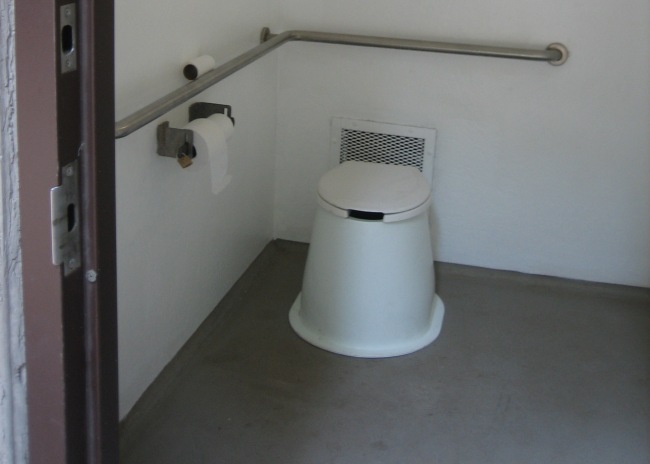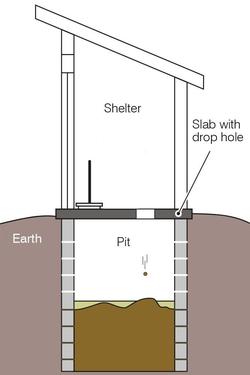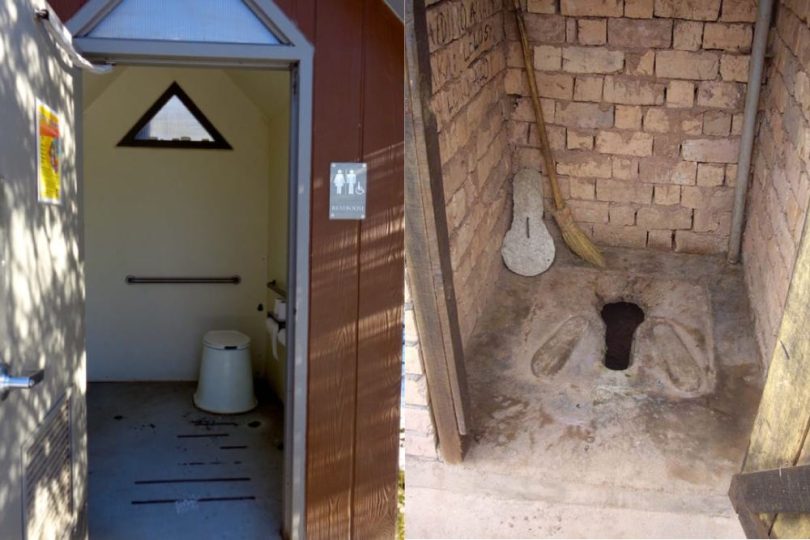Both vault and pit type toiles are good option if you want to live off the grid, or want to go waterless. Although they both essentially serve the same purpose, there are major differences between them when it comes to work principle, installation and maintenance.
Which one you should install largely depend on the type of land you’re using. There are some other factors that also dictate which waterless toilet is better suited where. Dig deep as we explore what sets these two waterless toilets apart and which one you should pick. Let’s go.
Table of Contents
Vault Toilet vs Pit Toilet: How Do They Differ?
| Comparing factors | Vault Toilet | Pit Toilet |
| Durability | Durable | Needs to be buried once full |
| Reuse | Reusable | Not reusable |
| Relocatability | Relocatable | Not relocatable |
| Eco-friendliness | Produces anaerobic waste, which is harmful | Waste becomes fertilizer |
| Maintenance | Needs regular cleaning and sanitization | Simple to maintain |
| Waste space requirement | Less | More |
| Smell | Generally odorless | Has a strong, foul odor |
| Effects on the surroundings | No effects | Nearby water resources can be contaminated |
| Cost | Expensive (around $1500) | Cheaper (simple design costs around $25 – $60) |
-
Durability
The vault toilet’s structure is durable and reusable/relocatable.
On the flip side, the pit needs to be buried once they are full.
-
The simplicity of maintenance
The pit toilet is simple to maintain whereas the vault toilet needs regular cleaning and sanitization.
Usually, waste materials in the pit make direct contact with the ground and decompose over a long time.
In contrast, the vault doesn’t have any access to the earth. As a result, they do not get any help from bacteria to decompose the waste. They become anaerobic waste, which is harmful to human health.
-
Which one to choose?
Though both the vault toilet and the pit toilet are waterless, they have a few differences.
Pit toilets are known as ecological toilets but if not built right, they may contaminate water resources nearby. Additionally, they take some time to decontaminate the extrements.
On the contrary, if you clean the vault regularly, your toilet is going to last forever. The waste does not take so much space like a pit, so they can be reused immediately for other purposes.
However, locations that have run out of pits need to install vault toilets.
What Is a Vault Toilet?
A vault toilet is a waterless, non-flush toilet that stores excreta temporarily.
These toilets can usually be found in parks, forests, remote work sites, campgrounds, and other public areas where water and sewerage lines are not available.
A standard vault holds 750 – 1000 gallons, but bigger ones can hold up to 13,000 gallons of waste.
How Does a Vault Toilet Work?
How to use them
Vault toilets contain a fiberglass riser over the hole and the toilet seat is placed on top of the riser.

Excreta and organic wastes
Parks, camps, and forests also empty organic wastes inside the vault.
A large airtight underground container holds all the feces, urine, water from shower cubicles, and other organic waste materials.
Sewage pumping trucks pump the waste out once the tank is full.
Dealing with bad odor
A ventilation pipe is installed over the roof to deal with bad odors. Besides, everyone is suggested to keep the toilet seat down after use.
Interestingly, the United States Forest Service introduced their vault toilets as “Sweet-smelling toilets”. According to them, a properly built, cleaned, and vented toilet should not smell.
If you are worried about the foul odor in your vault toilet, below mentioned tips might come in handy for you:
- Always keep the door closed and the toilet seat down
- Install vent pipe on the prevailing wind side
- Make sure no large tree is sabotaging the airflow of the building. If you have trees around the building, their height should never cross the height of the building.
If you are building a vault toilet in a deep forest, place a fan in the vent stack.
Steps to build a vault toilet
Step 1: Select the site, mark it and start excavating. Make room for the vault and footing form box first.
Step 2: Put together the footing form box to place beneath the vault. Once you are done, place the rebar on top of the box.
Step 3: It’s time to set the vault/tank. Don’t forget to make the tank level at grade. Additionally, you’ll need the rim elevation of the toilet riser adaptor to be the same as the finished floor elevation.
Step 4: It’s time to pour water into the tank. Don’t forget to fill the tank before you backfile around the tank with concrete.
Step 5: It’s time to build the slab. Form the structure with wood. Once finished, pour concrete through the center of the tank. This will top up the footing form box.
Step 6: Once the center column gets filled up; and after you make sure that the steel post is in the column, it’s time to backfill around the tank with concrete.
Step 7: Now complete the grading of the slab. After that, place the precast door frame supports.
Step 8: After the grading is done, place the poly floor pan designed for the restroom building.
Step 9: Now, carefully place the building over the pan. Don’t forget to level the door frame. Don’t forget to connect the poly building pan and the building.
Step 10: Once the installation is complete, shove the perimeter footings for the concluding slab and set the rebar.
Drill a few holes within the building. This will help you extend the rebar through the building part of the slab.
Step 11: Now you can safely place and attach the roof over the building. Drilling and installing toggle bolts in the assigned dimples will help you secure the roof neatly.
Step 12: Install the upper portion of the ventilation pipe and place the bird-proof screen on top of that. You also need to mark and cut the building to install the wall vent.
Step 13: It’s time to complete the last slab. Don’t forget to mask off the structure with a plastic/polythene cover beforehand. That way, the concrete won’t stain the walls.
Leave the slab for drying and once the slab dries completely, your vault toilet will be ready to use.
Advantages of a vault toilet?
-
Saves water
Did you know that we waste about 1.6 gallons of water per flush?
There are more than 7 billion people on earth and they use restrooms 6 to 7 times a day! Now let’s do the math. Can you imagine how much water is being wasted just to flush toilets?
On the other side of the coin, many people do not even have access to safe drinking water. More than 2 billion people live in such countries where the water supply is not enough.
According to UNICEF, half the world population could be living in places with water scarcity by 2030. So, waterless non-flush toilets are a blessing for our ongoing water crisis.
-
Advanced facilities in remote areas
Suppose you are going camping or working in remote areas. Where will you go at midnight if you need to use the washroom? Isn’t it convenient to have a healthy option right beside you?
Vault toilets can help you in these types of situations. On top of that, vault toilets are safer than going to an unknown forest or field!
-
User friendly
Vault toilets provide a healthy, easy, and private option for people that live off the grid. Additionally, they will not cost you extra for maintenance.
If you are concerned about your privacy, vault toilets assure complete privacy with a locking mechanism installed on the door.
-
Cost-effective and portable
Building a typical toilet can set you back around $1500.
On the other hand, the building and vault prices are between $500 to $5000 (excluding the labor cost) which can be affordable to many people. Of course, you’ll also have the option to install a fancy one.
Additionally, Vault toilets are usually made from heavy-duty plastic so, they are portable.
You can reuse them in case you need to change your location.
Disadvantages of a vault toilet?
-
Only plastic buildings are moveable
Not all vault toilets are portable. They can also be made from wood or concrete. Concrete structures are permanent to one location and wood structures are difficult to relocate. You can only move plastic buildings.
-
Regular Cleaning
The vault has limited capacity to hold waste. That’s why they need regular cleaning.
Depending on how frequently you use them, they may need cleaning sooner than anticipated.
This can be a challenge for parks or forests, especially if there is an explosion of tourists on a holiday.
-
Failure in ventilation system
A poor design or lack of maintenance may result in the failure of the ventilation system, which can pollute the surrounding area with a foul smell. This will be disgusting for people nearby.
-
Difficulty in managing waste
Without adequate roads, sewage trucks cannot get near a vault toilet. In case there is a clog, it will become much harder to unclog without professional help.
What Is a Pit Toilet?

Pit toilets are also a type of waterless latrine that collects human feces in a hole dug deep in the ground. They usually consist of three parts.
a) The holen the ground
b) Concrete slab
c) A shelter
Advantages of a pit toilet?
-
Water conservation
They are waterless just like vault toilets. So they are saving water in a similar way.
-
The excreta becomes fertilizer
All the waste is buried once the pit is full. Eventually, all the manures become a part of the soil, making the earth more fertile.
-
Easy and cost-effective to build
You can build pit toilets with local labor and cheap materials. The simple design costs around $25 – 60.
-
Prevents pollution
Before the invention of the pit toilet, people used to poop wherever possible, which is dangerous due to the presence of pathogens in feces.
With a pit toilet, the waste remains buried in one place and the bacteria cannot pollute the environment and spread diseases.
Disadvantages of a pit toilet?
-
Foul smell and flies
Most of the pit toilets aren’t properly ventilated or there are no ventilation systems at all. Consequently, you’ll experience a strong, foul odor and a lot of flies.
Besides, flies usually transfer pathogens (Microorganisms responsible for diseases) to the environment. They are responsible for diseases like diarrhea, cholera, typhoid, and many helminth infections.
-
Contamination of water resources
Many among us still don’t know the specifications of building an eco-friendly toilet.
To demonstrate, If you dig too deep or locate your toilet in a place where the water resources are closer, then groundwater or surface water will get contaminated.
A Pit needs to be at least 45.72 – 91.44 meters away from any surface water. Besides, soil type and groundwater depth should also be taken into consideration.
The best practice is to let a sanitary engineer locate the perfect place for your pit toilet, but many people do it themselves, risking the environment around them.
-
Emptying or relocation
Clearing the pit is tough and hazardous to human health. That is why it is recommended to relocate your pit toilet only when they are full.
Additionally, in some places, all the available sites for the pit are already used. As a result, these areas don’t have accessible pit sites.
This can be a serious problem if you want to install a new pit toilet.
-
Becomes a trap and slow decomposing
Another challenge of a pit toilet is that animals in rural areas may fall into an abandoned pit.
Additionally, feces in a pit decompose naturally, but the process is time-consuming. As a result, the pits remain contaminated for a long time.








Leave a Comment